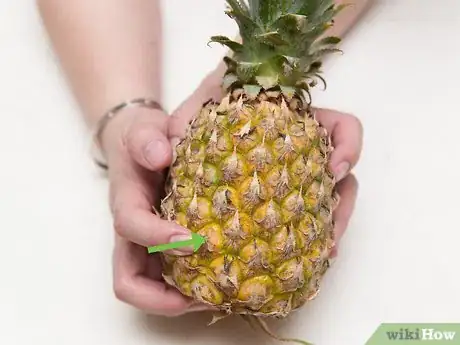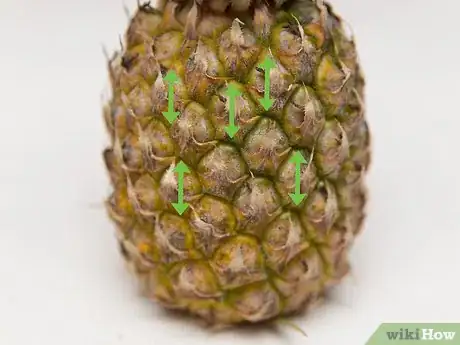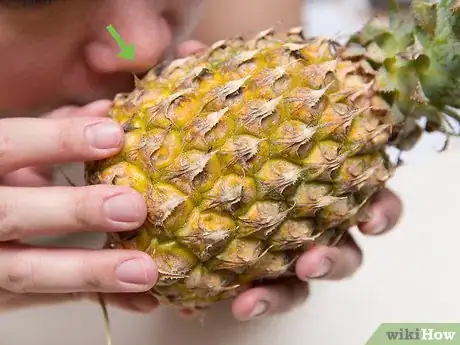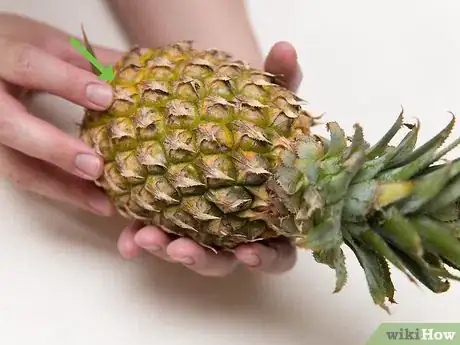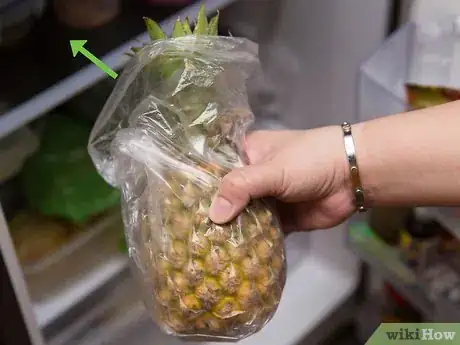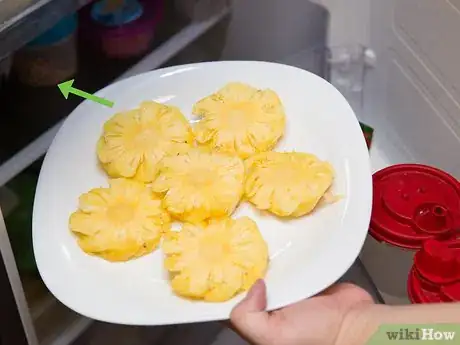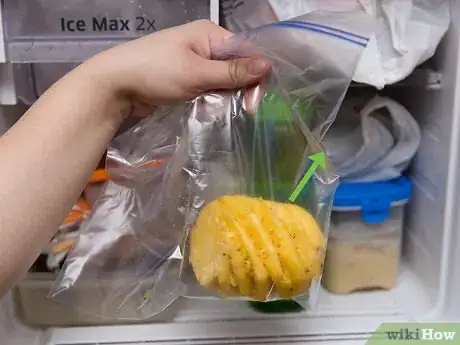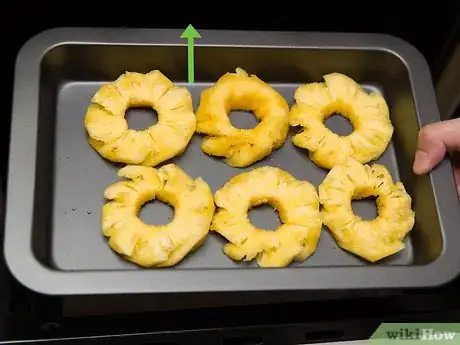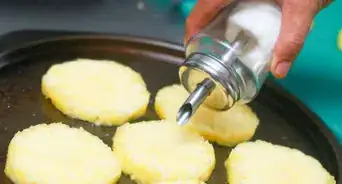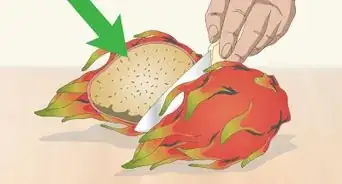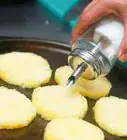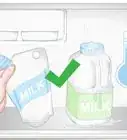This article was co-authored by Randall Chambers. Randall (Randy) Chambers is a Personal Chef and the Owner of Luxury Meals From Home based in Arvada, Colorado. He has more than 16 years of commercial kitchen experience, five years of sous chef experience, and two years of experience as an executive chef. Chef Randy draws inspiration from his half Bolivian background and his forte is South American cuisine. He holds an Associate’s degree in Culinary Arts from The Art Institute.
wikiHow marks an article as reader-approved once it receives enough positive feedback. This article has 14 testimonials from our readers, earning it our reader-approved status.
This article has been viewed 333,243 times.
Because pineapple does not continue to ripen after being harvested, it’s important to know how to choose a ripe one. Once you’ve mastered identifying the signs of ripeness and avoiding deterioration, you may want to store your pineapple to enjoy later. There are a number of methods to store your fruit depending on how long you want it to last.
Steps
Signs a Pineapple is Ripe & Fresh
-
1Vibrant yellow and green skin. The skin should be vibrant greens and yellows with no white or browned areas. Depending on the variety of the pineapple, the coloring should be more yellow than green.[1]
- The yellow-gold color should be present at least around the eyes of the fruit as well as around the base.
- While a pineapple can feasibly be ripe while fully green, there is very little way to know for sure that it is, so purchasing a fully green pineapple is risky.
- The higher up the pineapple the yellow-gold reaches, the more evenly flavored the pineapple.
-
2Heavy and not squishy. If the coloring of the pineapple fits the ideal description, that doesn’t guarantee that it’s ripe. In order to be certain, you should feel the consistency and yield of the skin.[2]
- Gently squeeze and press the bottom of the fruit.
- There should be no indented or squishy spots. A good pineapple that is ripe and juicy will feel heavy.
Advertisement -
3No mold around the eyes. They should all be similar in size and color and be free from mold. The eyes can be some of the stronger indicators as to whether or not the pineapple is ripe and sweet.
- Choose the pineapple with the largest eyes. The size of the eyes indicates how long the pineapple was left to ripen on the branch.
- Look for a pineapple with flat eyes. Flat eyes can indicate the sweetness of the fruit.
-
4Sweet smell and dull, solid sound. While the odor and sound of a pineapple are not necessarily strong indicators of its ripeness alone, in the presence of other indicators they can help you choose the best one.
- The smell of the pineapple should be sweet, but if it is too sweet and almost has a hint of alcohol, then it is beyond its freshness.
- A ripe fruit will have a dull, solid sound. Unripe fruits will sound hollow.
-
5Also look for signs of deterioration. Although you are looking for a fruit that has had enough time to fully ripen, you also need to look out for one that has spent too much time since being pulled from the branch. Once a pineapple begins to show signs of deterioration, it is considered over-ripe and is no longer a good choice.[3]
- A deteriorating pineapple will exhibit wrinkled skin and feel soft to the touch.
- Look for leaks or cracks in the fruit, both are strong signs of deterioration.
- The leaves of a deteriorating pineapple will appear brown and stiff.
Storing a Pineapple for a Short Time
-
1Store the pineapple on your counter. Pineapples do not need to be refrigerated for the first few days you have them at home. In fact, if you intend to eat your pineapple within a day or two of purchasing it, feel free to just store it on your counter.
- Keep an eye on your pineapple to make sure it doesn’t begin to exhibit signs of deterioration as it sits.
- It is recommended that you purchase your pineapple on the same day you intend to eat it so as to avoid deterioration.
-
2Refrigerate your pineapple whole. If you would like to prolong the life of your pineapple for a few more days, you can keep it in your refrigerator. Remember, pineapples do not have a significant shelf life even when refrigerated so it is recommended that you eat your pineapple within 3-5 days even when using this method.
- Wrap the pineapple in plastic before placing it in the refrigerator.
- Check the pineapple each day for signs of deterioration.
-
3Refrigerate sliced pineapple. You can prolong the life of your pineapple by another day or two beyond simply refrigerating it by slicing it first. It can be more difficult to know if your pineapple has begun to deteriorate once it is sliced, so it is recommended that you eat the pineapple within 6 days of purchase even using this method.[4]
- Use a serrated knife to cut off the top of the pineapple off, then slice off each of the sides.
- Once you have the outer portion of the pineapple removed, slice it to a thickness of your liking, then use a cookie cutter or knife to remove the core from the center of the slices.
- Store your pineapple slices in an airtight container like Tupperware to maximize its lifespan.
Storing a Pineapple for Extended Periods of Time
-
1Freeze fresh pineapple for long-term storage. You can prolong the life of your pineapple for as much as 12 months by freezing it. You will need to remove the skin and the core of the pineapple first.[5]
- Once the skin and core are removed from the pineapple, store it in an airtight container like Tupperware.
- Leave a small amount of air in the container with the pineapple.
-
2Use a dehydrator to dry pineapple for storage. If you happen to have a dehydrator, you can prepare and store your pineapple nearly indefinitely! Dehydrating removes the moisture from the pineapple and makes it a bit more like pineapple “chips” but with all the same nutritional value. [6]
- Use a sharp knife to peel, core and slice your pineapple. Make sure your slices are consistently about 1/2 inch (1.25 cm) thick.
- Place in your dehydrator according to the manufacturer's recommendation or at 130 degrees Fahrenheit (54 degrees Celsius) until the fruit reaches a leathery state but is not sticky.
- It may take 12-18 hours to be fully dehydrated.
-
3Can or jar your pineapple. The last possible method to storing your pineapple for an extended period of time is canning. Canning or jarring your pineapple can prolong its life for a year or more, but it is not recommended to store it for longer than a year to be safe.[7]
- Once again, slice and core your pineapple by cutting off the top and skins. This time, cutting the pineapple into chunks instead of slices may make it easier to can.
- You will need to boil your pineapple in a “packing” solution to occupy the additional space in the can and keep it moisturized. You can use apple juice, white grape juice or light to medium “canning syrup” you can buy at some specialty grocery stores.[8]
- After boiling the pineapple in the packing solution, fill your jars, leaving an inch or so of open space at the top.
- Place the lids on the jars finger tight, then place it (or however many you have) in a pot with water approximately 1-2 inches taller than the top of the jar or can.
- Boil the jars for 25 minutes for a pint jar, 30 minutes for quarts. After removing them, the air will have been evacuated and the pineapple will be good to store.
Community Q&A
-
QuestionDoes fresh pineapple continue to ripen after purchase?
 Community AnswerNo, once a pineapple has been picked, it ceases to ripen. It will soften and deteriorate, which some people mistake for ripening but does not improve the taste of the fruit whatsoever.
Community AnswerNo, once a pineapple has been picked, it ceases to ripen. It will soften and deteriorate, which some people mistake for ripening but does not improve the taste of the fruit whatsoever. -
QuestionI am having a party and using cored-out pineapples as a centerpiece with flowers in them. How long in advance can I purchase the pineapples?
 Community AnswerNo longer than four days in advance.
Community AnswerNo longer than four days in advance. -
QuestionShould the pineapple be stored standing up or on it's side?
 Community AnswerIt does not actually matter how you stand the pineapple while you store it, however slicing and coring your pineapple and storing it in an airtight container will maintain its freshness longer.
Community AnswerIt does not actually matter how you stand the pineapple while you store it, however slicing and coring your pineapple and storing it in an airtight container will maintain its freshness longer.
References
- ↑ http://www.nytimes.com/1982/04/21/garden/a-guide-to-choosing-a-ripe-pineapple.html
- ↑ http://www.nytimes.com/1982/04/21/garden/a-guide-to-choosing-a-ripe-pineapple.html
- ↑ http://www.nytimes.com/1982/04/21/garden/a-guide-to-choosing-a-ripe-pineapple.html
- ↑ http://www.goodhousekeeping.com/food-recipes/cooking/tips/g1935/cut-whole-pineapple/
- ↑ http://nchfp.uga.edu/how/freeze/pineapple.html
- ↑ http://selfreliantschool.com/how-to-dehydrate-fresh-pineapple/
- ↑ http://foodinjars.com/2015/01/canning-101-long-home-canned-foods-really-last/
- ↑ http://www.sbcanning.com/2013/03/canning-pineapple-chunks-from-fresh.html
About This Article
To buy and store fresh pineapple, start by selecting a pineapple that has vibrant yellow and green skin with no white or browned areas. Next, gently squeeze the fruit to check that it’s firm but still has a little give. Additionally, make sure that all the eyes are similar in size and color, and are free of mold. If you plan on eating your pineapple within a few days, you can simply place it on the counter. Alternatively, wrap it in a clear plastic bag and keep it in the refrigerator for up to 5 days. For more tips, including how to freeze your pineapple for up to 12 months, read on!
